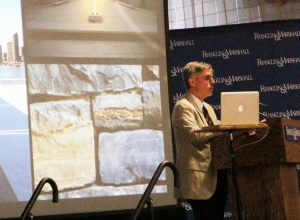Christa Rodriguez || Contributing Writer
 In this week’s Common Hour, William Whitaker spoke about the making of Franklin D. Roosevelt Four Freedoms Park, as well as the architecture of other memorials.
In this week’s Common Hour, William Whitaker spoke about the making of Franklin D. Roosevelt Four Freedoms Park, as well as the architecture of other memorials.
Whitaker is an Architectural Archives curator and collections manager at the University of Pennsylvania. Specifically, He is the curator of “The Louis I. Kahn Collection.” He also co-curated more than 30 exhibitions and co-authored “The Houses of Louis I. Kahn” with George Marcus. He is one of the top three world experts on Kahn, and played a role in crafting Kahn’s vision for Four Freedoms Park.
“The best way to learn about architecture is to experience it,” Whitaker said.
Louis Kahn was commissioned for the project in December 1972, but Kahn died in March 1974, before any of the construction had begun. The park opened in 2012 on Roosevelt Island in New York City, 40 years after it was originally commissioned. It is a presidential memorial, and specifically honors the four freedoms Roosevelt emphasized during his presidency: freedom of speech, freedom of worship, freedom from want, and freedom from fear.
Whitaker pointed out that Kahn and Roosevelt had similar physical attributes, which shows an interesting connection between them. Roosevelt contracted polio later in life, causing muscle weakness in his legs. At three years old, Kahn was severely burned, leaving scarring on his face. He also had scarlet fever at a young age, which altered his voice. Khan said these physical challenges may have given each man a greater sense of empathy.
Louis Kahn was born in Estonia and moved to Philadelphia, where he lived in poverty. He studied at the architecture school at the University of Pennsylvania. Kahn aimed to achieve a timeless sense of architecture and Whitaker advocated for Kahn’s original vision when working on the project.
Before Kahn died, he was heavily in debt. This was partly because he kept redesigning his visions for the architecture, which Whitaker said is “the cost of great art.” The Commonwealth of Pennsylvania paid off the debt. The year after Kahn died, Pennsylvania got ready for construction but then stopped again after more financial issues.
In 2008 the project got going again. Kahn noted that everything in the park, including geometry and space, was a conscious choice. Whitaker showed the original architectural sketches and plans, which included a grove of trees where, he said, “the noise of the world slows down.” The plans incorporated an “intriguing monumental set of steps” that open up to the sky. The top of the steps reach a garden with rows of trees and walls are on either side, creating a sense of enclosure. At the distant end of the garden there is a bust of Roosevelt.
The welcoming sculpture of the president’s head represents his voice from his fireside chats. When visitors pass by the president the walls disappear,
“[This creates] a sense of spatial release; the President is asking us to let down our guard,” Whitaker said.
The marks on the granite capture sunlight, which animates the surface. The light joints and shadow points created by light passing through the cracks of the granite channel energy of the world around. As visitors leave they see an excerpt from Roosevelt’s freedom speech.
“This is what you walk away with and take back into the world,” Whitaker remarked.
Whitaker gave six items of reflection for monuments. The first item includes words, names and rituals, which can be used powerfully. The second is sacred objects in memorials to which we can relate. Thirdly, the location works at “setting a world apart.” Fourth, is the idea of “spareness” in what the artist chooses to leave out. The fifth, craftsmanship, represents a certain impression of the work to take away from it. Finally, movement is the journey that the memorial takes visitors on as well as what it asks of them.
Whitaker encouraged the audience to create our own connections as they are revealed by the art of architecture.
Christa Rodriguez is a freshman contributing writer. Her email is crodrigu@fandm.edu.